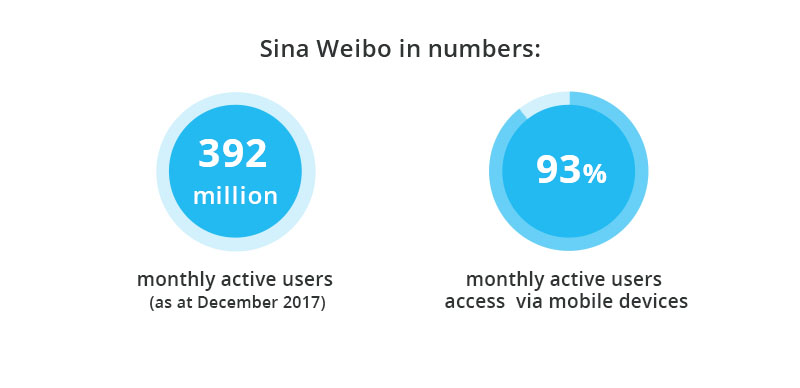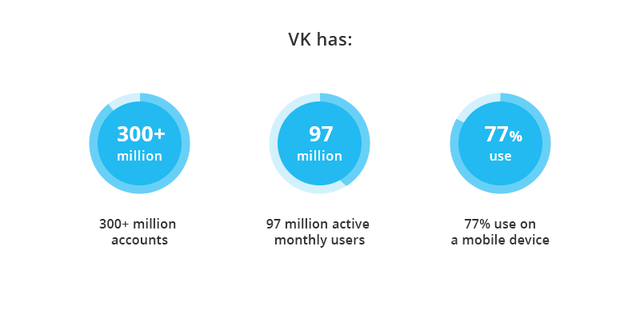Ideas for online video content when you can’t show games
Thanks to deals between sports leagues and broadcasters, games are now accessible all over the world. Fans can watch Premier League games in Los Angeles or the Super Bowl in Mumbai – and have become accustomed to the luxury of watching their team on TV or via a streaming service.
For many clubs, they’re unable to stream games on their own social media channels because the rights are in the hands of a league or federation. Yet the huge growth in digital viewing behaviours and the appetite for online video means that clubs are often left wondering how they can get involved. For those fans unable to watch live games at a stadium, or pay for a TV/streaming service, there’s often not much content left for them to enjoy.
Check out our other stories:
- The most common live video streaming habits of digital audiences
- Still looking for a prime alternative to Snappy TV?
But this situation for both clubs and fans can be changed very easily. If you’re part of a club, here’s a list of content ideas you can use to generate great video content, and keep your fans engaged, well informed and bonded to your club community.
Press conferences – before and after games
Fans like to hear why their team lost or know how the dressing room feels after winning. What influenced the coach to use a particular strategy, or why did they wait so long to make a crucial substitution. How are preparations going for the next game? The best way to give your fans all the answers they need is by broadcasting your press conferences.
Injury updates
In sport, injuries are part of life. But when it happens to a key player, fans get really worried. Back in 2006, Leo Messi suffered a metatarsal fracture that ended in 87 days off and him missing 18 games[1]. Imagine how Barca fans would feel if it happened again. That’s why regular injury updates, interviews with doctors and reports on the recovery process are a great source of information for fans.
Other teams’ matches
While fans are often focused on a club’s main team, many clubs have much more to show: a women’s team, the second team and youth academy teams. These games also present huge opportunities and will be of interest to many fans.
Stadium tours
For those of fans unable to visit the stadium, an online tour might not substitute a real trip but it is the next best thing. You could show some of the most important places for the team: the locker room, trophy galleries and entrance onto the pitch, as well as fan areas and the press box.
This kind of video tour can also act as a commercial to attract fans to visit the stadium more often and as a way to market to potential buyers of hospitality boxes.
Pre-season games
Pre-season games are a chance to show how new players are performing and for fans to check out any changes in formation. It is an exciting time for fans who have been looking forward to seeing games after weeks off in between seasons.
Presentations
Everything that happens at a club is interesting for its core supporters. It’s worth sharing club moments with fans, such as the signing of new player, the promotion of a youth academy player to the first team, or the presentation of a new kit. There will be lots more ideas you can come up with.
Player challenges
A great way to entertain fans is to organise challenges, so players can show off their skills (or lack of them!). If you need ideas, simply look on YouTube as it’s amazing how many great ideas you can find for this kind of competition.
Match day preparations
This can be really nice for fans, especially for the most important games of the season, such as the first home game, a playoff, derby match or even a final. If you don’t have rights to the actual game, you might show your team’s pre-game routine: their breakfast, the trip to the stadium, warm ups and any final preparations before kick off.
Community events
If your club is active in your local community, this is also something that’s worth sharing. Whether it’s a tournament for your youngest fans, or a festival-style event that brings players and fans together.
Fans asking, players responding
This is something many fans like to do – to ask their favourite players about their life and career. You might collect questions via social media and ask your players or training staff to answer them. Remember: this doesn’t have to be 100% serious! The more fun to watch, the better the results will be.
‘Season in a minute’ summaries
It’s great to show your supporters an end of season summary. Whether it’s been full of ups and downs, or a season of trophies, it’s nice to show some extras.
Even if you’re unable to stream club games, there are plenty of things you can show your fans. You just need to stay open to ideas and look around at life in your club. Creating and sharing video content will not only positively influence your marketing efforts, but will keep your fans even more engaged. It’s worth a shot!
[1] https://www.transfermarkt.com/lionel-messi/verletzungen/spieler/28003
How Facebook is creating its own sports streaming service and what we can all learn from it
In August 2017, when Facebook launched its video platform – Facebook Watch – it was a bold move to target the huge growth in online video consumption. Video is by far the most engaging content type[1]. It’s also relatively easy to monetise. So Facebook Watch is no great surprise, as it provides the social media giant with an on-demand service for longer-form video content and a space to promote its own video productions.
Facebook’s reasoning is actually very clear: People love watching video and Facebook wants to earn money from adverts shown in those videos. But, while Facebook has made it super easy to stream and publish videos on their platform – and with consumption still growing – there has never been one central place to find video content on the platform.
To find video content, Facebook users have to scroll down their feeds or use the search feature (which is far from useful when it comes to video search). Facebook has been aware of these limitations for some time – realising it’s not good enough if they want to be a serious player in the video market and why people still prefer to watch videos on YouTube or via on-demand services.
With Watch (released only in US so far), Facebook now has a go-to central area where users can easily find video content, which Facebook hopes will rival the likes of YouTube.
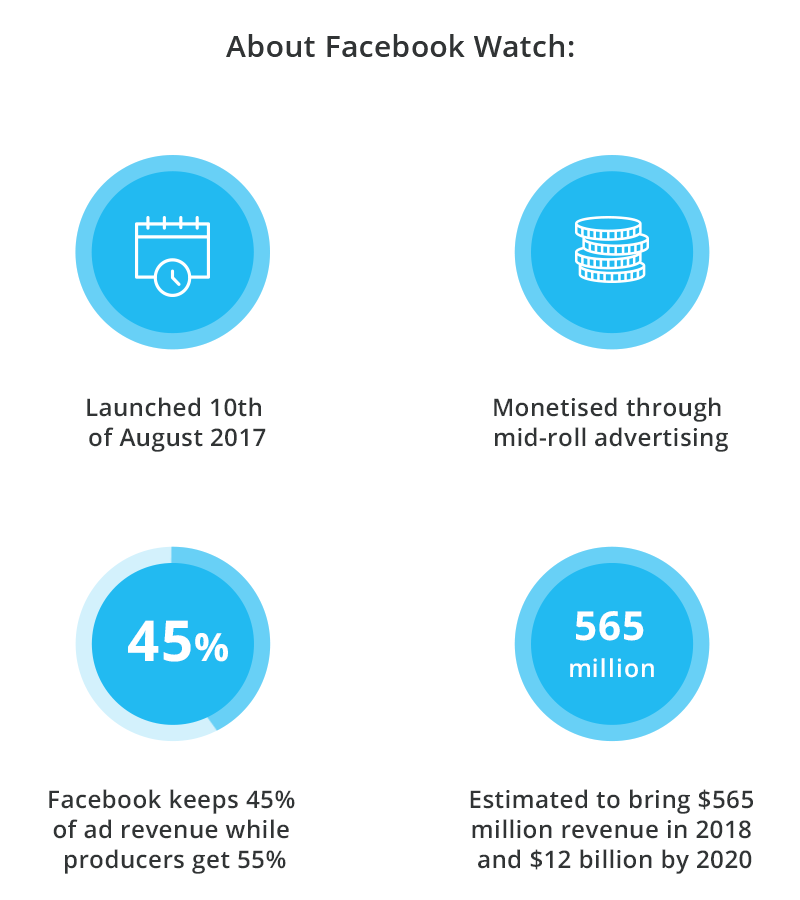
What’s inside Facebook Watch?
Video is not going to disappear from a user’s feed, but with Facebook Watch there will be more professional productions served in a better way. Watch’s menu is mostly a mix of comedy, documentaries, reality shows and documentary series dedicated to sports. The latter include shows like:
- Ball in the Family – dedicated to talented basketball players within Ball family and its notorious patriarch, LaVar. See how Ball’s family build their popularity with their video appearances here.
- Behind the Wall – showcasing NASCAR driver Bubba Wallace’s preparations for the Daytona 500 race.
- Bill Murray & Brian Doyle-Murray’s Extra Innings – which follows everyone’s favourite Bill Murray and his brother Brian Doyle-Murray, visiting Minor League ballparks where they explore small but strong communities dedicated to baseball.
- Fly Guys – which shows talented acrobats and their preparations to perform new stunts.
In the above, it’s easy to spot that Facebook Watch’s sports dedicated shows are not focused on mainstream events like playoffs etc. Instead they show what we used to call ‘behind the scenes’ in the cinema industry – for example, a look behind leagues like the NBA. Each episode of a series is often only 9 to 25 minutes long, just enough for online audiences.
Sports streaming – the future of Watch?
At the moment Facebook is relatively limited by the streaming rights secured by traditional broadcasters. If this doesn’t sound ambitious enough for you – it is still the first year of Facebook’s efforts to create their own TV on-demand service with sports at the fore.
However, Facebook is definitely positioning itself as an important player when it comes to buying streaming rights in the future. They already have lots of experience streaming live sports (deals with NBA, Liga MX, MLS, MLB) and now, with Watch, they have an on-demand platform on which to build for the future.
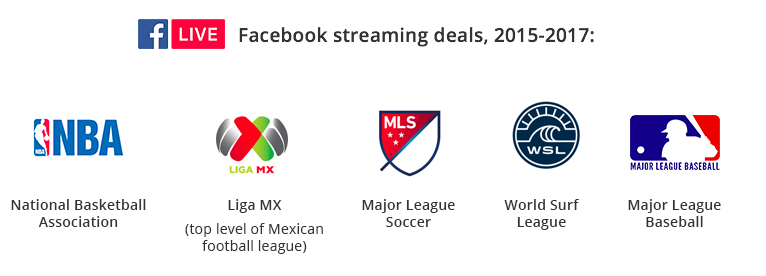
With such a sports streaming strategy in place, it seems there’s really nothing to stop Facebook from becoming the #1 digital sports streaming platform.
Ok, but I don’t have such resources!
Facebook’s plan to create an on-demand platform that will displace traditional TV in terms of sports streaming is ambitious. There are not many companies that could try this and succeed. But even smaller organisations like sport federations, leagues and associations can learn a few lessons.
Here are some tips for you:
First of all – start producing video. It’s the content of today and tomorrow, pretty affordable and will have a huge impact on your fanbase. No matter if you are producing five events per year or your league organises 200 games each season, video is more effective at creating online engagement than any other content type. Every day without video is your loss!
Next – include live video streaming in your marketing strategy. In the sports industry (and any other live-based industry to be honest) being here and now is everything. But you need to bear in mind that your fans aren’t always able to visit the stadium. If your organisation is international, you need to reach out to your global fans. Fans everywhere will want to see your content!
I bet you have plenty to offer your fans – so now tell your story! Use different content types and play with video. Create viral GIFs, best-play compilations, bloopers etc. Don’t limit yourself to the day of your event only – be active all the time, pump up the atmosphere surrounding important games and get involved in your fan community. See how big sports clubs are keeping their fans excited with creative video content here.
Once you start creating and showing your video content, remember that your audience will be watching it everywhere[2]. Literally! If you want to keep them entertained, make your videos mobile-friendly. Especially if you’re focusing on social media, as it’s consumed largely on mobiles. If you want to know more about mobile suited formats, click here.
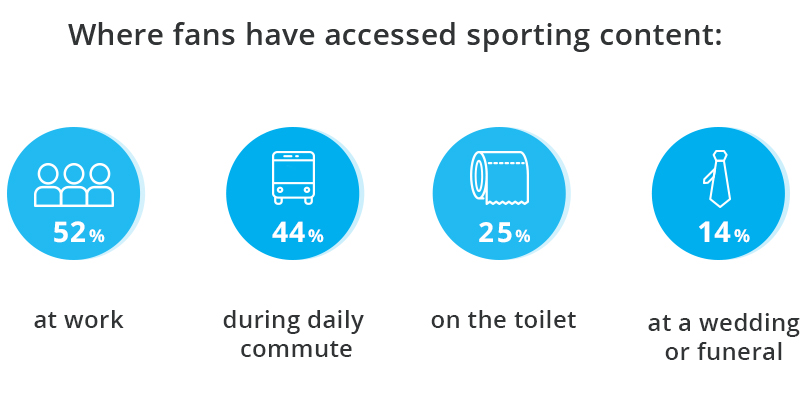
With your own video content and a vibrant community built around your events, club, league or organisation you can finally monetise your productions. Involve your business partners and give them and their branding visibility in your videos. You can easily measure views and the reach of videos – extremely helpful data when negotiating advertising deals. You might create your own on-demand video platform or sell video subscriptions to allow fans around the world to see what you have to offer.
Even if you already have a streaming rights contract, there’s still a lot of stuff you can show – such as interviews with players, press conferences, training sessions or locker room insights. With some creative thinking there will be a plethora of things you can show to your audience. Just try to think outside the usual video-content box!
While not everyone has Facebook’s ambitions and resources, it’s important to realise that an effective video and live streaming strategy is possible to execute for organisations of all sizes and from a range of different industries. And, if you’re going to learn, then learn from the best! Meanwhile, why not consider one of our products – Tellyo Pro or Tellyo On Demand. See what suits your needs the best!
A snapshot of internet, social media and sports consumption in Asia
Asia is a fascinating region: a colossal continent with countless cultures and traditions. When it comes to internet and social media use it’s equally diverse – from high penetration in south east Asia to its lowest in central Asia[1]; while elsewhere Thais spend the most time on the web and Filipinos the greatest amount of time on social media.
With the aim of uniting the international sports marketing and media industry with opportunities across Asia, Sportel Asia is taking place between 13-15 March. So, I thought I would look here at some of the biggest trends in Asian social media and sports.
Check for other sports and social media related stories:
- What makes real-time sports videos engaging?
- Local social media to explore – VK in Russia
- A quick guide to understanding esports and gaming fans
China – a growing social media and sports superpower
China alone has 772 million internet users[2]. Yet the country still has millions of people that have yet to access the internet, which means there is huge opportunity for growth.
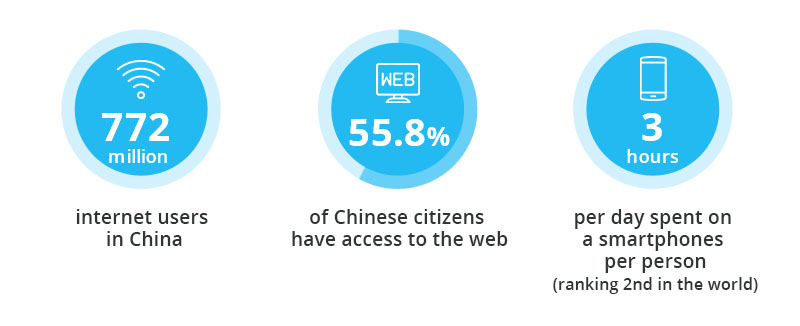
Unlike many countries across the globe, Facebook is not a social media leader in China. Instead, Chinese people tend to use the microblogging network – Sina Weibo. It’s the most important Chinese social network – a source of everyday information and a platform where Chinese people consume huge amounts of content.
Weibo – home of sports stars
According to Nielsen[5], China’s emergence as a sports superpower is no secret. And, as one of the biggest social networks in China, Sina Weibo is natural place for sports stars to be seen and found – in particular European football stars!
On Weibo, there’s an enormous demand for fresh content and information dedicated to the best football leagues in Europe. The most popular football club in China is Manchester United, with Real Madrid and Bayern Munich coming in second and third place respectively. [6] Man Utd is the most followed sports club on Weibo.
The most popular player is Lionel Messi (duh!), with Cristiano Ronaldo coming in second place. However, third place is pretty unexpected: Anthony Martial of Manchester United, which only highlights the uniqueness of the Chinese market.
To rise and shine in China, one of the biggest internet markets in the world, being present on Sina Weibo is a must, not an option.
Football in Indonesia
The popularity of football clubs in China is a reflection of the huge demand for soccer-based content in Asia in general. Super Soccer TV, the Indonesian online-based television network, focuses on football and has a huge demand for its content. Indonesia itself currently ranks 3rd for social media growth (between 2017-2018 at 23%) with football fans often looking for content online through social channels.
Tellyo works with Super Soccer TV to support the live streaming of matches and the creation of short-form football clips for fans to enjoy across the web and social media. The network’s popular channel – supersoccer.tv – acts as a one-stop shop, which can be accessed online, on the go, whenever people want to find football content.
Cricket in Asia
Let’s change the optics a little bit. Do you know what sport is popular in India, Pakistan, and Hong Kong but also in the United Kingdom, Australia and South Africa, all at the same time? If you thought of cricket – then you’re right!
This sport is massively popular amongst millions of people across the globe and there are many cricket tournaments for fans to enjoy worldwide. At Tellyo, we had the great honour to support one of the most prestigious tournaments – The Hong Kong Sixes – that took place at the end of October 2017.
It was great lesson for us – to work with such an engaged, committed audience and millions of viewers who watched the live games online. The event’s organisers were able to provide live streams to a truly multinational audience, which was spread over dozens of countries and across four continents. Live streaming and social media results during the two days of matches were mind-blowing:
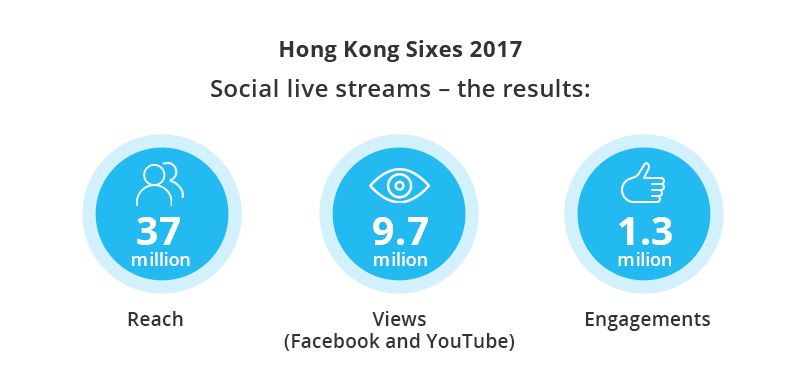
With Hong Kong Sixes’ live streams and video content proving 60x more engaging than photos or text posts, these are sure-fire ways to feed the passion and emotion of fans across the world.
The above examples of social media usage in Asia also give us interesting insights into how you might promote your sport or video content in Asia. You need to approach it holistically:
- Take into account the specifics of each country, keeping in mind its limitations and opportunities, while making use of background internet and social media stats to support your chosen direction.
- Look for the similarities that join people from different backgrounds, so you can reach further than one country, if that’s your chosen goal.
Baffled? If you need a tool that can help you with either providing content to current audiences, or reaching new ones, just let us know. Regardless of your approach, industry and experience – we know how to help.
What makes real-time sports videos engaging?
It’s a good question to pose: what does make a real-time sports video engaging? Having worked with the International Table Tennis Federation (ITTF) for a year now, we feel we’ve developed a deeper understanding from what they’ve created and shared through our platform.
In this blog, we’ll take a look at some of the ITTF’s best moments of 2017 – a year that was truly amazing for the organisation, the players and the sport itself. Here at Tellyo, we’re extremely proud to work with the ITTF – the largest international sports federation in the world – to help them distribute such amazing events and historical moments across social media and to thousands of table tennis fans.
Here are their best, most epic video moments of 2017.
Did it hit?
Full of emotion and utterly unpredictable, sport has it all at times. Millimetres can separate players, with even the best referees sometimes struggling to make a call. Here’s what happened during the women’s finals of the ITTF World Cup.
Was the referee’s verdict right? Did the ball hit the table, or miss by millimetres? Watching the above video, we could argue all night long without any satisfactory conclusion; while the video’s comments section is also proof that fans love to watch this kind of content, to debate decisions and make their own call.

The Did it hit? video reached more than 6 million people, gained 1.3 million views and achieved more than 200 shares! And, just for the record, it was Zhu Yuling who won this amazing game!
The turning point
Every tournament features great personalities and the narrative of an underdog fighting their way to victory. Table tennis is no different. At the 2017 World Table Tennis Championships, the audience was treated to one of the most amazing games in the history of table tennis, ever.
Lin Gaoyuan had a five match points lead against Xu Xin, the world number three. More often than not, the winner would be obvious. But not this time, as Xu Xin kept pressing and won the game point by point, proving that table tennis is one of the most amazing and thrilling sports to watch.
Published on the ITTF’s Facebook page, it was table tennis’s equivalent of the 2005 Champions League Final between Liverpool and Milan. It reached more than 17 million, and achieved 1.7million views and 55,000 engagements, including over 7,000 shares!
Teenagers for the win
Born in 2003, Tomokazu Harimoto is table tennis’s teenage prodigy. Back in August 2017 he won the men’s singles title during ITTF World Tour in the Czech Republic. Aged 14, he became the youngest player ever to win the title, or any similar title, beating much older and more experienced players – something that doesn’t happen very often in professional sports.
Here’s one of the most popular ITTF videos from 2017: Harimoto winning against former Olympic bronze medallist, Jun Mizutani, who was two-times older than Harimoto at the time.
The video of Harimoto’s win reached 1.5 million and achieved almost 300,000 views on Facebook and Twitter.
What have we learned from these epic moments?
Online engagement is triggered by moments that represent the very essence of sport:
- The high emotion of being a sports fan
- Unusual turn of events or controversial decisions that sway matches
- The narrative of underdogs and youngsters defeating those considered to be masters
- Heroes like 14-year-old Harimoto who are quickly taken to people’s hearts
The ITTF videos shared above certainly resonated in some way with audiences – be it through emotion, or the narrative of an underdog or hero – and engagement levels rocketed as a result.
To experience even more epic moments, stay tuned for the upcoming 2018 ITTF Team World Cup being hosted in London.
Maximise great moments in sport, just like the Minnesota Miracle
The 52nd Super Bowl Final hits our screens this weekend. The road to the final has been full of trials and tribulations. Yet, it’s the Minnesota Vikings’ failure to reach Sunday’s game that epitomises the extreme highs and lows of American Football’s annual showpiece.
See other, sports related stories:
- The future of sports fans: what should you expect
- 5 sports clubs keeping fans excited with creative video content
The Vikings’ failure was the ultimate price of their 38-7 loss to the Philadelphia Eagles – a result which only added to the team’s historical playoff woes. Minnesota have now lost six NFC championship play-off games over a 42-season span, causing some to call it a curse.
“There is no damn curse,” said Vikings coach Mike Zimmer to local paper, The Star Tribune.
Yet only a week before the Eagles loss the Vikings were on a high. In a dramatic last-minute moment, they had won their divisional round, defeating the New Orleans Saints 29-24. The stars seemed to align for the Vikings that night. With the game at third-and-10 on the Minnesota 39-yard line and with only 10 seconds on the clock, the Vikings were down 24-23. Yet, somehow, Stefon Diggs pulled off a game-winning touchdown in the dying seconds, causing many to ask: How the hell did the Vikings pull off the Minnesota Miracle?
.@STEFONDIGGS FOR THE WIN!!!!!!!!! #SKOL #NOvsMIN #NFLPlayoffs pic.twitter.com/UAoNJ2NJ97
— NFL (@NFL) January 15, 2018
Diggs’s touchdown was one of those moments in sport that generates pure excitement, something fans all over the world live for. It was also a moment that blew up across social media and generated huge levels of engagement.
How could you maximise such a moment in your sport?
If such a miraculous moment happened in your sport, what would you do? Like the Vikings, how would you amplify it through video content, and help fans everywhere to relive what happened and celebrate your success? Let’s take a look at three aspects of our Tellyo platform that would help.
Multi-camera footage
Tellyo is able to ingest footage from multiple devices – video cameras, smartphones and drones – giving you the option to live stream and share clips from different angles. The Vikings did something similar by sharing footage from their Side Line Cam. Although only from one camera, it added an alternative take on that touchdown (a video short that has since been nominated for a prestigious Shorty Award).
? #MinneapolisMiracle Sideline Cam#BringItHome pic.twitter.com/fRe9CZTlwt
— Minnesota Vikings (@Vikings) January 15, 2018
Live clipping
While the Viking’s clip is undoubtedly awesome, Tellyo’s ability is to take such a clip, mix it with several other angles and publish within minutes of an event happening. The Tellyo video editor puts this level of video production at your fingertips.
In the case of the Vikings, they live clipped and shared the reaction of its player, Everson Griffen, who was simply lost for words. His reaction seemed to sum up the #MinneapolisMiracle.
The #MinneapolisMiracle was so crazy, even @EversonGriffen was lost for words.#BringItHome pic.twitter.com/OXTd9L4pjJ
— Minnesota Vikings (@Vikings) January 16, 2018
Social publishing
As a memorable moment happens, everyone wants to be a part of it. Social media is the place where people want to experience these moments and share them with friends. That’s why Tellyo enables you to publish videos to multiple social media channels simultaneously, with the ability to add messages and hashtags.
The results can be staggering. Once shared, the Vikings’ Cam clip immediately racked up 500,000 views, and has since achieved 8 million total views and counting[1]. The club’s #MinneapolisMiracle social media effort has also generated a whopping 360 million mentions to date!
If you’d like to maximise the moments that matter in your sport, feel free to get in contact with our team to discuss how Tellyo can help.
What’s in store for social video in 2018
With 2018 well underway, I took the time to ask a few of my colleagues and Tellyo customers what they feel is in store for social video this year.
Here are their thoughts and predictions:
“2018 will see a direct-to-audience offering become the norm, in which social is fully accepted as a mainstream video channel to reach and engage audiences. For top-tier sports or major broadcasters, such an offering will complement and extend the reach of existing content, engaging younger demographics effectively and providing further touch points for fans and viewers. In the case of niche sports, this will be the year to choose a direct offering as a primary channel, with a comprehensive content schedule around all events and key moments.
There’s no doubt that technology has changed what is possible, even if you have more limited resources. What we’ll see across the board is better video production and content, more experimentation and innovation, and a richer experience for audiences when content is shared directly with them. Those organisations that succeed will achieve constant exposure and greater engagement, with this having a positive effect on revenue.”
“To succeed online in 2018, it will be important for sports clubs, leagues and federations to continually evolve with the social video production technology they use and the platforms they choose to partner with.
For federations like ours, the year ahead is further opportunity to ‘do it yourself’ – to push forward with the production and distribution tools that provide us with the autonomy to create highly engaging content. It’s this content that positively impacts how fans experience our tournaments and brand globally, be it via a live stream or a social media video clip.”

“2018 will be the year in which broadcasters and producers push for more from the technology available to them. This is being driven by viewers’ expectations of the technology and their desire to experience truly high-quality digital streams.
While live streaming will only grow in popularity, 2018 will also see it evolve. With all the major platforms now offering users the chance to live stream, producers and broadcasters will adapt in the coming year to prevent audiences from tuning out as the ‘live’ novelty wears off. We’ll see a more holistic approach to social broadcasts take shape, with social media, video clips and multi-device considerations increasingly playing a role.”
“While more and more people consume video content through social media and smartphones, this is both an opportunity for marketers but also a challenge to grapple with in 2018. Over the coming year, this challenge will need to be taken head on, particularly as engagement with video will increase in tandem with consumption.
As a result, there will be a spike in demand for solutions that can deliver video content to different platforms simultaneously. Marketers will want confidence in the way they can manage multiple video formats across platforms, eyeing the frictionless engagement that this will bring. Essentially 2018 will be the year in which marketers get complete control of how video is presented for mobiles and social media platforms with suitable APIs.”

“2018 will see us make much more of social media-friendly short clips of our skaters, mountain bikers, BMXers and wakeboarders. This sort of content sits well with the ephemeral content that our younger audience loves nowadays – such as the short-lived social video clips that you see on social media platforms.
During our 2018 World Series, we’ll also continue to mix clips with live streams. This way we can recreate the live experience of our events online, amplifying the excitement and buzz at each event, and so reaching and engaging with more people across social media.”
Have we missed anything? Feel free to tweet your thoughts and predictions to us @TellyoTV
Local social media to explore – VK in Russia
The internet in 2018 might look like a monolith at times, especially from an English-speaking perspective: Facebook, Netflix, the next iPhone release. However, there’s lots of life outside of this Western mainstream bubble.
So, if you’re planning to target new regions and reach broader global audiences with your video content, you might want to consider what other local solutions and platforms are available to you.
Interested in sports-related topics? Check out our other stories:
- Great sports personalities to follow at the 2018 Winter Olympics in PyeongChang.
- A quick guide to understanding esports and gaming fans.
Here, I would like to introduce you to VK – the main social network in Russia, the 9th most populated country in the world.
In touch with VK
Launched in 2006, VK (VKontakte, which translates as ‘in touch’) is an extremely successful social network. It’s very popular in Russia and some former soviet republics, like Belarus, Kazakhstan and Ukraine, but also receives a noticeable amount of traffic from Germany[1].
VK is ranked as the 11th most popular website in the world, which means it’s more popular than Twitter, Amazon, Instagram or Wikipedia globally. Needless to say, it is number one in Russia and even more popular than the country’s two leading search engines – Russian Yandex and Google!
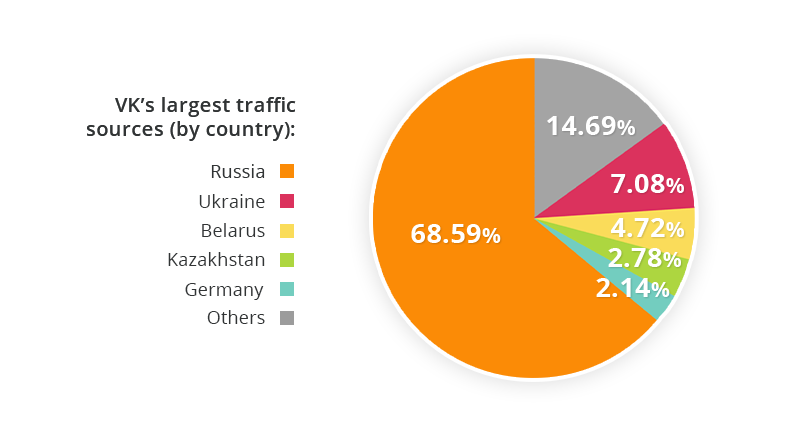
For lots of reasons, VK is often compared to Facebook. Its features are pretty similar to Mark Zuckerberg’s platform. The interface uses a blue colour that Facebook users will be familiar with and overall the functionality is comparable.
VK’s users can publish their thoughts, photos and videos on their profiles, connect with friends and follow communities (like FB groups or profiles). Users are known to consider the network as easier to use and more transparent than Facebook, and that’s probably one of the reasons why VK is more popular in Russia than Facebook.
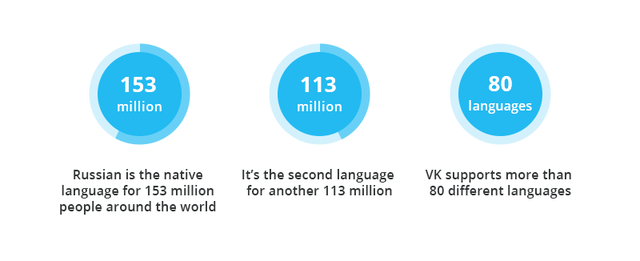
Video hosting is central to VK
VK is widely used as a video hosting platform. Users make the most of VK’s features to share a wide selection of different video types.
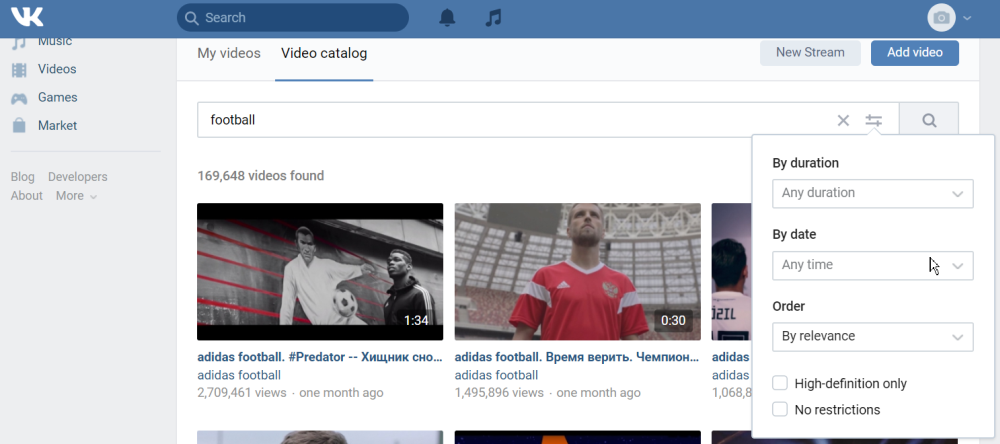
Contrary to Facebook, VK also has a really neat search engine, which is a powerful tool that allows users to search for video content pretty easily, using convenient sets of parameters. Thanks to its search, VK is more akin to YouTube, as you can search through past and present video content with ease.
To picture how big and important the service is in Russia: VK has a bigger monthly audience than any Russian TV station, including the public service, Channel 1[3].
Social media in Russia = VK
VK is full of really strong communities (groups) created around or dedicated to different brands. These groups are created by users in praise of brands. However, the content published within each group is often not in tune with a brand’s own standards. To understand this better, let’s take a look at Nike[4].
Nike on VK
The biggest group dedicated to the brand has more than 1.6million users, while all three of the official Russian Nike profiles have around a third of that amount in total.
The unofficial groups are often used to share content that is interesting to its community and not content controlled by the brand. For example, the biggest VK group called ‘Nike’ is often dominated by game trailers or funny pictures, most unrelated to sports products. This throws up interesting questions about how you might connect with these groups, and influencers could play a vital role here.
The official Nike profiles tend to make use of numerous sets of VK tools to promote the Nike brand, including built-in e-commerce and sponsored content.
For other brands wanting to enter VK, don’t worry as the tools are already there for all to use, ready to help boost the visibility of your brand. Here at Tellyo, our cloud-based video production platform also integrates with VK, enabling you to easily publish video content to the social network.
Other brands on VK
Among other big sports brands present on VK, you can find FC Bayern Munich and Manchester City, but also the NBA, UEFA and dozens of video game titles. There are also many global fashion and beauty brands fighting for the attention of a Russian audience. If there is no official account of a global brand, there will be at least one or two groups dedicated to them.
What’s in it for you?
VK users are very receptive towards big, international brands. Brands can benefit remarkably from being present and active on this Russian social media network, where online communities play a huge role. So, if you’re thinking about developing a greater presence in Russia, then being on VK is a must and key to potential fans and customers noticing your content and brand. And we’re here to help, as our Tellyo platform integrates seamlessly with VK, meaning you can reach audiences on this social channel with real-time video content.
If you’d like to find our more, drop a message to contact@tellyo.com.
Local social media to explore – VK in Russia
The internet in 2018 might look like a monolith at times, especially from an English-speaking perspective: Facebook, Netflix, the next iPhone release. However, there’s lots of life outside of this Western mainstream bubble.
So, if you’re planning to target new regions and reach broader global audiences with your video content, you might want to consider what other local solutions and platforms are available to you.
Interested in sports-related topics? Check out our other stories:
- Great sports personalities to follow at the 2018 Winter Olympics in PyeongChang.
- A quick guide to understanding esports and gaming fans.
Here, I would like to introduce you to VK – the main social network in Russia, the 9th most populated country in the world.
In touch with VK
Launched in 2006, VK (VKontakte, which translates as ‘in touch’) is an extremely successful social network. It’s very popular in Russia and some former soviet republics, like Belarus, Kazakhstan and Ukraine, but also receives a noticeable amount of traffic from Germany[1].
VK is ranked as the 11th most popular website in the world, which means it’s more popular than Twitter, Amazon, Instagram or Wikipedia globally. Needless to say, it is number one in Russia and even more popular than the country’s two leading search engines – Russian Yandex and Google!

For lots of reasons, VK is often compared to Facebook. Its features are pretty similar to Mark Zuckerberg’s platform. The interface uses a blue colour that Facebook users will be familiar with and overall the functionality is comparable.
VK’s users can publish their thoughts, photos and videos on their profiles, connect with friends and follow communities (like FB groups or profiles). Users are known to consider the network as easier to use and more transparent than Facebook, and that’s probably one of the reasons why VK is more popular in Russia than Facebook.

Video hosting is central to VK
VK is widely used as a video hosting platform. Users make the most of VK’s features to share a wide selection of different video types.

Contrary to Facebook, VK also has a really neat search engine, which is a powerful tool that allows users to search for video content pretty easily, using convenient sets of parameters. Thanks to its search, VK is more akin to YouTube, as you can search through past and present video content with ease.
To picture how big and important the service is in Russia: VK has a bigger monthly audience than any Russian TV station, including the public service, Channel 1[3].
Social media in Russia = VK
VK is full of really strong communities (groups) created around or dedicated to different brands. These groups are created by users in praise of brands. However, the content published within each group is often not in tune with a brand’s own standards. To understand this better, let’s take a look at Nike[4].
Nike on VK
The biggest group dedicated to the brand has more than 1.6million users, while all three of the official Russian Nike profiles have around a third of that amount in total.
The unofficial groups are often used to share content that is interesting to its community and not content controlled by the brand. For example, the biggest VK group called ‘Nike’ is often dominated by game trailers or funny pictures, most unrelated to sports products. This throws up interesting questions about how you might connect with these groups, and influencers could play a vital role here.
The official Nike profiles tend to make use of numerous sets of VK tools to promote the Nike brand, including built-in e-commerce and sponsored content.
For other brands wanting to enter VK, don’t worry as the tools are already there for all to use, ready to help boost the visibility of your brand. Here at Tellyo, our cloud-based video production platform also integrates with VK, enabling you to easily publish video content to the social network.
Other brands on VK
Among other big sports brands present on VK, you can find FC Bayern Munich and Manchester City, but also the NBA, UEFA and dozens of video game titles. There are also many global fashion and beauty brands fighting for the attention of a Russian audience. If there is no official account of a global brand, there will be at least one or two groups dedicated to them.
What’s in it for you?
VK users are very receptive towards big, international brands. Brands can benefit remarkably from being present and active on this Russian social media network, where online communities play a huge role. So, if you’re thinking about developing a greater presence in Russia, then being on VK is a must and key to potential fans and customers noticing your content and brand. And we’re here to help, as our Tellyo platform integrates seamlessly with VK, meaning you can reach audiences on this social channel with real-time video content.
If you’d like to find our more, drop a message to contact@tellyo.com.
Great sports personalities to follow at the 2018 Winter Olympics in PyeongChang
The Winter Olympics in PyeongChang is just around the corner! Although most of us won’t be there in person, we will watch online or follow our favourite athletes, sports and countries.
There is much to be excited about. A 5G network is being trialled in the South Korean region for the duration of the games. The technology is likely to be a game changer in terms of watching online video and live streaming.
Check out our other stories:
- Social media and live sports: a modern love story
- 5 sports clubs keeping fans excited with creative video content
Whatever way you’re planning to connect with the Winter Olympics in PyeongChang – be it on TV, online or on your phone – I’ve pulled together seven athletes you might not know about. They’re all worth following on social media before, during and after PyeongChang – and all use great video content as part of their social profiles. Ladies first!
Read more on how to boost your social media presence with Tellyo in our case study section.
Lindsey Vonn – Cross Skier, Team USA
On Instagram you get to see first-hand what Lindsey Vonn does best, such as intense training clips. Like most people, if you’re curious about how the athletes prepare to win gold, then Vonn’s Insta-stream is for you.
Lolo Jones – Bobsledder, Team USA
Lolo Jones’s Instagram is packed full of live updates on her progression to PyeongChang. It shows her training, no matter the weather, and how she pushes herself to be better. Jones’s stream is a mix of videos with a sense of humour and day-to-day updates. Here is one about how being athlete can be both funny, dangerous and embarrassing!
Belle Brockhoff – Snowboarder, Team Australia
Snowboarder Belle Brockhoff runs a very stylised Instagram stream, featuring fantastic photos and amazing scenery. It’s a stream full of beautiful mountains, great views and tons of dynamic picture shots, often in black and white. A master class in how to make snowboarding look ultra-cool.
Hilary Knight – Ice Hockey Player, Team USA
Over on Facebook, Hilary Knight uses the platform to offer a great compilation of her life, sporting events and travels with the USA team. If you’re a fan of Knight, then her stream provides lots of insights, positive messages and showcases the great spirit in women’s hockey.
Tessa Virtue – Ice Skater, Team Canada
Tessa Virtue has already been to two Olympics and has been skating with her ice partner, Scott Moir, for twenty years. On Instagram, Tessa shares lots of videos with their fans – from rehearsals to training sessions and behind the scenes clips. Beside video, there are lots of pictures with notes on the stories behind them.
Russ Henshaw – Skier, Team Australia
When it comes to sharing videos, Russ Henshaw is king of the mountains! Not many athletes will share only video, but Henshaw goes out of his way to give us a look at every practice run and his race runs in competitions.
Sebastien Toutant – Snowboarder, Team Canada
Seb Toots’s Twitter account is an insight into a millennial who is ‘living the dream’ (his words). He is very active on Twitter, sharing important news with his fans, showcasing short video clips, and providing updates on competition rankings and runs. It’s a fun and lively snowboarding stream for the 21st century!
Mario kart ! ??#nintendo ?#snowboarding #volumeup pic.twitter.com/zFKivSmuW5
— Sebastien Toutant (@SebToots) October 20, 2017
Have you got a favourite Winter Olympian you’d like to share with us? Then share yours with us on Twitter @TellyoTV
The future of sports fans: what should you expect?
What does the future look like for the sports industry and sports broadcasters? Who will be watching sports in the future, and how? An interesting report – The future of sports fans – by Performance Communications and Canvas8 provides a glimpse into what we can all expect.
On reading the report, one thing is for sure, if you don’t like change then you’re in for a white-knuckle ride. Here, I’m going to look at some of the report’s key points and stats, so fasten your seatbelt and prepare for a thrilling trip to the near future.
Huge changes are happening
The report makes it clear that we are on the edge of huge changes. In relation to sports fans – their habits, needs and the technologies they use are changing. To meet these new demands, the sports industry, content producers and broadcasters will need to shift current policies and practices, and be open to new ideas and ways of doing things.
Content is consumed everywhere… literally!
Timing in sports is so much more important than with any other TV produced content. You can watch your favourite movie every single year, or wait for the full season of your favourite series to watch in a row, but you can’t miss a game of your club.
You may find it interesting as well: 5 sports clubs keeping fans excited with creative video content.
The driver for much of this is the emotion that people attach to sports. Passion is high when there is only one game per week, with such intense emotions rising and falling for a couple of hours before and after. If it’s not a Champions League final or the Super Bowl, emotions will fade pretty quickly afterwards.
Almost all sport related content is transmitted live as events happen, with only 7% time shifted (for other TV produced content one third is not live). This is why sports fans are so eager to use mobile devices to watch sports – they’re not forced to sit at home or in the pub to see and follow live events any more. Instead, they’re using smartphones and tablets to follow live results, catch replays or actual games thanks to mobile-friendly sports services. For example, the American leader in the TV-sports industry – ESPN – often has two-thirds of its audience visiting ESPN services via a mobile only.
For 73% of fans it’s important to be able to access sports whenever and from wherever they want, as the below graphic shows:
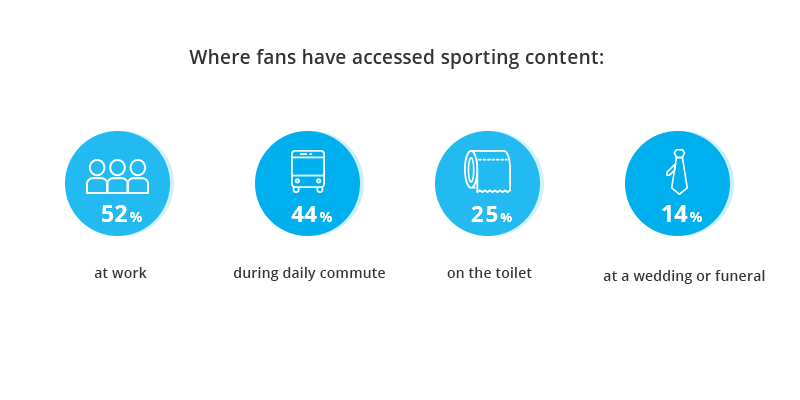
Well, whoever is without sin, cast the first stone!
[bctt tweet=”75% of people taking part in the research have watched a replay on their phone at a live venue!” username=”TellyoTV”]
Pro tip for broadcasters: Let the audience consume your content in the manner they choose and at the most convenient time for them.
Pre and after game content is crucial
Live sports broadcasts are ephemeral – they come and go at specific times. However, sports audiences are very keen to watch content before an event and after it. The day before a game or event, fan consumption of sport related videos increases by 75%, as the audience seeks information about their team and the game itself.
This represents a great opportunity for rights holders and broadcasters alike – to improve your social media presence and reach many more fans with timely content.
Pro tip for broadcasters: Plan events very carefully – don’t forget to produce some pre-event warm-up videos and post-event summaries.
The audience is tech savvy
The quality and attractiveness of content is extremely important for viewers. They want to see different types of content, including live streams, short clips, compilations, highlights etc. However, all the content you offer has to be high quality. For example, 50% of fans say that interactive slow-motion replays would improve the fan experience, and 3 in 5 want to have the ability to choose different camera angles.
While those technologies are yet to come, these responses provide more evidence that sports audiences are both tech savvy and demanding when it comes to technology’s capabilities. Also, they want to influence the way they consume videos now and in the future.
Pro tip for broadcasters: Not every breakthrough technology is going to became standard – do you remember Google Glasses? But the pace of technological changes rapid and you should always keep an eye on interesting trends. Your audience is hungry for them!
Make piracy useless
Web piracy is a huge problem for many industries, including web streaming and broadcasting businesses.
In 2015, the fight between boxing superstars Floyd Mayweather Jr. and Manny Pacquiao was streamed to about 10,000 users via Periscope, for free.
Piracy can be as simple as pointing your smartphone at a TV screen and hitting ‘go live’. And there will be thousands of people happy to watch for free, despite the poor quality and obvious piracy.

Is there a clever way to stop such piracy? While the law is on the side of rights holders, there is no silver bullet to prevent piracy. However, there are dependable things that broadcasters can do to minimise losses.
The most obvious would be to provide an attractive and affordable offer to potential viewers. Whether subscription based or pay per view, if your service is easy to access and affordable there’s a great chance that a potential pirate will choose a high-quality and convenient but paid solution. But only if that viewer is able to see the content in the way they want!
Pro tip for broadcasters: The best way to get rid of piracy is to make it obsolete. While there are regions in the world where you can’t compete with piracy, it’s important to keep your offer attractive and customised.
Keep your eyes open
Soccer, American football, basketball and cricket might be the most popular sports, but many broadcasters might be missing something that statisticians and marketers are calling ‘long tail’.
What is long tail? In relation to sports it means that there might be a number of less popular sports that when combined have a similar or perhaps an even bigger value than mainstream sports. While it would be extremely difficult to doubt the popularity of the world’s leading sports, it is worth checking what’s going on in esports, women’s soccer leagues or newer sports that are gaining popularity. It looks like the underdogs will have their day, eventually.
This is what sports fans are thinking in terms of mainstream and less popular sports:
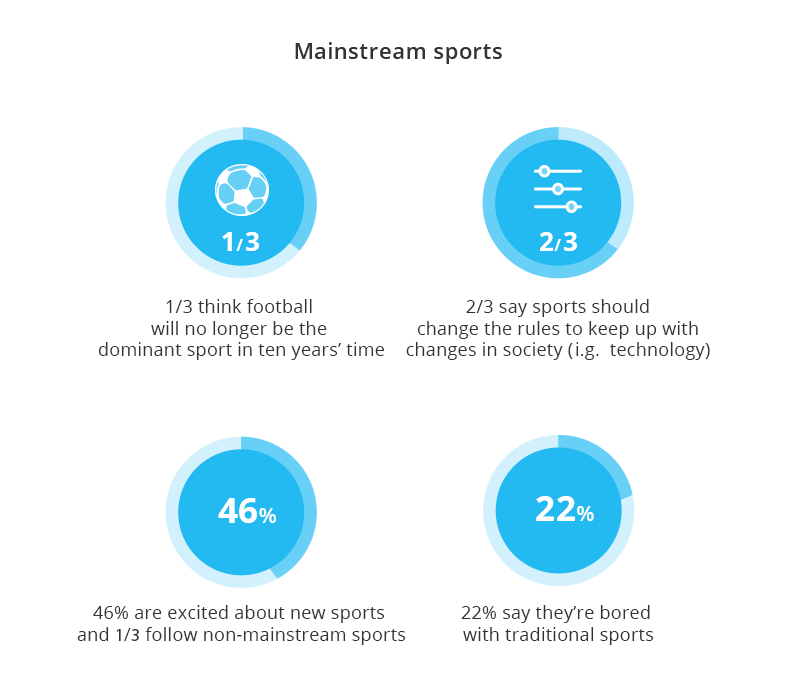
What seems pretty logical is that the home for non-mainstream sports is often on digital media platforms:
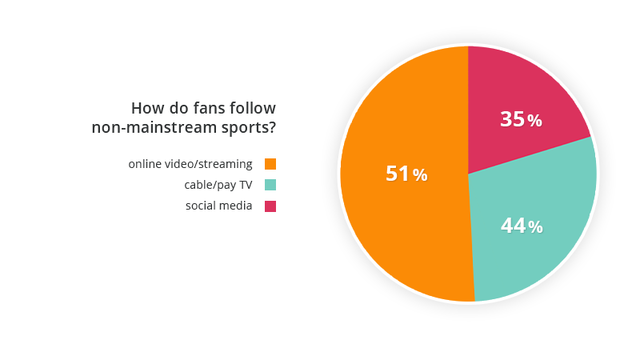
Pro tip for broadcasters: Football, soccer and basketball are leaders, while there are hundreds of ‘long tail’ sports with engaged audiences often following online and via social media. Combining these sports together could bring interesting results.
Change is the only constant
While there is not a universal strategy for sports broadcasters who are entering the social media and online world, one thing is for sure… Being immune to the changes that are occurring now is the best recipe for disaster. If you want to succeed, stay open minded and be ready for change.
You can download the report here.





